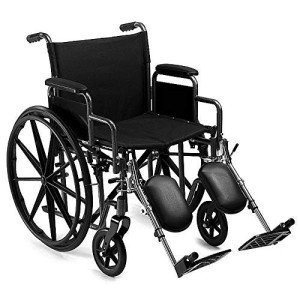10 Life Lessons We Can Learn From Bariatric Wheelchair 24 Inch Seat

Bariatric Wheelchair Seat Width
Seat Width
Having the proper seat width is essential to wheelchair users who spend longer durations in their chairs. Too narrow a seat will cause pressure on the hips and thighs which could cause sores or pressure points. Having too wide a seat can also make it tough for the user to reach the hand rims to propel themselves or maneuver in little areas.

To determine the appropriate seat width a person would rest on a chair typically and have their measurement taken across their lap at the widest point which is typically their hips. A wheelchair determining tape can be utilized to measure this, however a yard stick is chosen as it prevents individuals from wrapping the tape around their hips which would give an unreliable result.
The standard wheelchair seat width is 16" (narrow adult), 18" (standard grownup), and 20" (large grownup). For bariatric clients, a 24" seat is readily available. This durable additional broad bariatric wheelchair from Medline includes swing-away footrests, a carbon steel frame with rust- and chip-resistant chrome plating, and easy-to-clean vinyl upholstery. It has a weight capacity of 500 pounds.
Seat Depth
Generally, the seat depth of a bariatric wheelchair was added 2" to the measurement taken at the user's widest point (normally their hips). This was suggested to accommodate additional layers of clothing that may be worn throughout cold weather condition. Nevertheless, this practice is becoming less typical as wheelchair users are able to spend more time indoors and are not using long coats. This makes the seat depth of a chair less important when picking a bariatric wheelchair. However, it is still crucial to pick an option that provides sufficient support for bigger users.
The Medline folding additional broad bariatric manual wheelchair includes a comfortable 24" seat width and a durable slide tube silver vein frame. It likewise has an adjustable axle and tool-free elevating legrests.
Seat Height
When it pertains to determining the proper wheelchair seat width you must constantly determine from the user's largest point which is typically their hips. You will also require to think about whether the user is going to be using a winter season coat as this might include 2" to the width required.
When a wheelchair remains in usage it must just be run on level surface areas with the wheel locks fully engaged. This is to avoid the chair from being able to move slopes that are 10 degrees or greater. bariatric wheelchair 22 inch is also crucial to remember that any activity that might shift the center of mass in the chair ought to be done with care. This consists of grabbing products that need the person to lean out of their seat or trying to stand from it.
Whenever you have the chair in use it is recommended that you frequently inspect it for damage and oil any locations that are considered necessary. For example, the casters should be lubed by removing the caster fork and using a multi-purpose grease to apply to the caster stem bearings. Also, the foot plates can be changed by loosening up the bolt and then moving them to the wanted position. This allows the feet to sit easily on the footplate and avoids any pressure points from forming. This can be extremely uncomfortable for the user and if left ignored, can lead to press sores.
Weight Capacity
Bariatric wheelchairs are designed to support more weight than standard wheelchairs. This makes them stronger and much better geared up to deal with falls. They are likewise normally bigger and larger, making them less maneuverable in tight spaces than standard wheelchairs. They require vehicles with special ramps and lifts to load them, as well as drivers who know how to finest transport them from one area to the next.
When selecting a wheelchair, consider its weight capacity as it will be the main determining consider whether it will accommodate your guest's needs. The weight capacity of the chair is often noted as a fixed load, meaning that it indicates the quantity of weight the chair can comfortably hold while standing still. However, some producers likewise note an active load that is based upon a drop test and can imitate the effect of somebody sitting down in the chair. This might be a more reputable measurement of the weight limit, depending upon your requirements.
If you plan to carry out activities that shift your center of mass in the seat (such as grabbing items), make sure to have front casters pointed in a forward instructions and wheel locks engaged so the chair will not tip over. Also, inspect that casters are lubricated routinely to avoid extreme wear and abrasions. The lubrication treatment involves eliminating the fork, separating the caster from the wheel, and greasing the caster stem bearings with high-quality multi-purpose grease.
